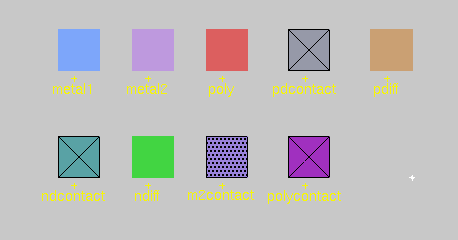Starting Magic, Text and Graphics Windows
Magic must be run from a workstation that supports the Unix X Windows system (although it can be easily compiled for Linux at home). Once you login to the Unix machine that runs Magic and setup your environmental variables (using source magic.cshrc), Magic is started by the shell command:prompt> magic [-Ttechnology] [file without .mag extension]where technology is the name of the fabrication technology that the design is intended for, and file is the name of the file that you edit. You could type any file name for file, and Magic would start editing that file. If a file with this name does not exist, Magic will create it. If the technology option is omitted, the layout is done in a default technology.
After starting Magic, two new windows will appear: a graphics (paint) window, and a text command window. Several startup messages will appear in the command window, followed by a "%" prompt.
Magic is not a menu-driven program: the layout shows up in the graphics window, but most commands must be entered in the text command. Both windows are ordinary X windows which can be moved and resized using the mouse. X windows (and Magic) assume you are using a three-button mouse. With a two-button mouse, pressing both buttons at the same time is equivalent to pressing the middle button.
The graphics window is where your layout artwork will appear layout. To work in this window, move the cursor to the window and click the left mouse button. This makes the graphics window active. The mouse should always point to the graphics window.
The command window is used to enter commands and read status and error messages that appear in response to commands. It is convenient to position this window under the graphics window so that both windows are visible at the same time. All commands you want to invoke should be typed in the text window. All error messages are also displayed in this window. Commands can be invoked in Magic in three ways:
- By pressing buttons on the mouse;
- By typing single-character macro commands while the mouse is in the graphics window
- By typing long commands on the keyboard at the prompt "%" in the command window. These can be entered from the graphics window by preceding the written command with a colon ( :). Alternatively, you can click on the command window and enter the command without a colon.
Scalable Design, Lambda and the GridMagic uses what is called scalable or "lambda-based" design. In scalable design, layout items are aligned to a grid which represents a basic unit of spacing. For a particular technology, lambda represents an actual distance (e.g., lambda = 0.3 um for the ON Semiconductor C5N SCMOS technology) files to modify and also where to add the technolgoy file. However, in Magic all designs are done in terms of lambda, not in terms of actual distances. The paint window is a layout surface on which items can be placed with a resolution of one lambda.
Magic has a grid which can be set to an arbitrary multiple of lambda. The default value of this grid is one lambda by one lambda. The grid of n lambda by n lambda can be displayed using the :grid n command. The g macro toggles the grid on and off.
The Cursor and the ToolsThe mouse cursor is used to select, point to, and manipulate objects on the graphics window. The shape of the cursor indicates which of the four available tools is currently being used. Pressing the space bar macro toggles between the 4 tools available:
Box Tool - this is the default tool and is indicated by a crosshair cursor. It is used to position the box and to paint and erase; this is the tool used for all basic drawing tasks. The use of the box tool is described below in the Basic drawing section and in more detail in the Magic Tutorial #1: Getting Started and Magic Tutorial #2: Basic Painting and Selection .The box tool is sufficient for basic editing. The purpose of the box tool is to specify a rectangular area ofWiring Tool is indicated by an arrow cursor and is used for advanced drawing tasks such as wiring and plowing. See the Wiring section below and the more detailed Magic Tutorial #3: Advanced Painting Netlist Tool is indicated by a box cursor. See Magic Tutorial #7: Netlist and Routing Rsim Tool is indicated by a hand cursor. See Magic Tutorial #11: Using RSIM with Magic
the layout for editing. The left and right mouse buttons are used to position the box. If you click on the left mouse button, the box will move so that its lower left corner is at the cursor position. If you click on the right mouse button, the upper right corner of the box will move to the cursor position, but the lower left corner will not change. The two mouse clicks are sufficient to position the box with arbitrary size anywhere on the screen.
Some Useful Global CommandsHere is a short list of useful global commands. These commands can be typed in at any time.
:help command prints out a brief description of all the commands or the specified command.
:load circuit-name loads circuit-name into the window; if circuit-name doesn't exist, Magic creates a new empty circuit.
:save circuit-name saves all the changes to the circuit.
:view or v fits the window with everything drawn thus far..
:grid or g toggles a grid. Useful for lining up various cells, wires, etc.
:zoom amount zooms in and out by a factor of amount, i.e. :zoom 2 zooms in twice as much, and :zoom 0.5 zooms out twice as much. The z macro zooms out to fit the box on the paint window. The Z macro zooms in the same as the :zoom 2 command
:macro displays all current macros
:quit quits Magic.
Cells, Paint and LayersIn Magic, a circuit layout is a hierarchical collection of cells. Each cell contains three things: colored shapes, called paint, that define the circuit's structure; textual labels attached to the paint; and subcells, which are instances of other cells.
The two basic layout operations are painting and erasing. They can be invoked using the :paint and :erase
commands, or using the mouse buttons.:paint layers (paints rectangular regions, specified by the box)
:erase layers (deletes the specified layers from the region under the box)
In each of these commands layers is one or more names separated by commas. In Magic there is one paint layer for each kind of conducting material (polysilicon, ndiffusion, metal1, etc.), plus one additional paint layer for each kind of transistor (n-transistor, p-transistor, etc.), and, finally, one further paint layer for each kind of contact (pcontact, ndcontact, m2contact, etc.).
To display the layers available in a process, go to the "Options" menu and select the "Toolbar" item. This will display a palette of layers along the right edge of the graphics window. When you place the cursor over each palette item, Magic will display the name of the layer in the status bar at th top of the window.
The easiest way to paint and erase is with mouse buttons. To paint, position the box over the area you'd like to paint, then move the cursor over the desired layer in the toolbar and click the middle mouse button (i.e. click both the left and the right mouse button at the same time on a two-button mouse). You can also copy existing paint anywhere in the graphics window; by clicking the middle button over this paint; this will copy whatever paint is under the mouse into the box. To erase everything in an area, place the box over the area, move the cursor over a blank spot, and click the middle mouse button. While you are painting, white dots may occasionally appear and disappear. These are design rule violations and will be explained in Design Rule Checking.
Relations between the physical cross-section of an example circuit and various Magic layers can be found in this example for a typical CMOS process.
Here's a legend of relevant colors/layers:
| Name of layer |
|
| p or poly or polysilicon or red | polysilicon (gate areas) |
| green or ndiff or ndiffusion | n-diffusion (n+ source/drain areas) |
| brown or pdiff or pdiffusion | p-diffusion (p+ source/drain areas) |
| blue or metal1 or m1 | metal layer 1 |
| purple or metal2 or m2 | metal layer 2 |
| pw or pwell | p-well |
| nw or nwell | n-well |
| nsc or nsubstratencontact or nwc or nwellcontact | metal1 to n-well contact (n-tub tie) |
| psc or psubstratepcontact or pwc or pwellcontact | metal1 to p-substrate contact (p-tub tie) |
| ndc or ndcontact | metal1 to n-diffusion contact |
| pdc or pdcontact | metal1 to p-diffusion contact |
| pc or polycontact | metal1 to poly contact |
| m2contact or m2c or via1 | metal2 to metal1 contact |
| m3contact or m3c or via2 | metal3 to metal2 contact |
| nfet or ntransistor | n-transistor |
| pfet or ptransistor | p-transistor |
Some layers are created by crossing two layers. For example drawing poly over ndiff (or vice versa) will produce an n-transistor. Contacts are made by placing the box over the region of the contact and by painting the appropriate contact. For example, to create a contact between ndiffusion and metal1 layers, place a box over an overlap between the two layers and type :paint ndc command.For a complete list of layers use the Magic command :paint help.
Basic drawing
The box and cursor are used to select things on the layout window. The left and right mouse buttons are used to position the box:After drawing a box, you can paint layers using command :paint layer or by clicking the middle button as explained in the Cells, Paint and Layers section above. To select a certain piece of the layout, move the cursor over the block you want to select, and type s, which is a macro for :select. A thin white outline is left around the block to show it has been selected. Using the macro s repeatedly at the same spot will toggle through electrically connected layers. This is a useful method to make a quick check of how things are connected in your layout design. The macro S (macro for :select more ) is just like s except that it adds on to the selection, rather than replacing it. For a synopsis of all the options to the :select command, type :select help. You can also select an entire area of stuff. Place the box over the area you want selected, and type :select area or macro a. If you want to know what's selected, type :what .click on the left mouse button to position the lower left corner of the box; click on the right mouse button to set the upper right corner of the box. The following commands can be used to maneuver the selected part of the layout:
:move (macro m), and keypad macros 2, 4, 6, and 8 (to move by 1 lambda in different directions);The best way to learn these commands is to try them out. Often you may want to restore things after you've made mistakes using:
:stretch (macro M), and keypad macros SHIFT-2, SHIFT-4, SHIFT-6, and SHIFT-8;
:upsidedown (macro F)
:sideways (macro f)
:clockwise (macro r)
:copy (macro c)
:delete (macro d)
:erase:undo (macro u)Make sure that you delete any paint that you don't want. Painting over something with another color just adds more layers, your original paint will still be there underneath.
:redo (macro U)You can use the "." (dot) macro to repeat the last command.
The easiest way to move around the graphics window is to use the "CTRL-SHIFT-Z" macro, which centers the window around the cursor position, together with the :zoom n command, (or z and Z macros) to zoom in and out.
Basic drawing is explained in more detail in the Magic Tutorial #1: Getting Started and the Magic Tutorial #2: Basic Painting and Selection.
LabelsIn order to make your layout readable, and to prepare your layout for extraction and simulation, you need to label it. First decide where you want your label. Then left click and right click at that spot. You should end up with a small cross (+). Then type
:label labelnameLabel names can be anything, but it is a good idea to use the labels that will correspond to circuit signals and make the layout readable. In particular, for digital simulation using the IRSIM simulator (and some other applications that can use Magic outputs), it is necessary to label the supply wires (nodes) as Vdd! and GND! (the ! means that the node is global).
WiringUsing the Box Tool to paint every little piece of a layout may not be the most efficient. The Wiring Tool allows you to extend existing paint, and to make contacts between layers. Once you have set down a few boxes of paint, you can connect them together with "wires."
Switch to the Wiring Tool, typing either :tool or space-bar macro until you get there. Now left click on the paint that you would like the wire to start from. Magic will automatically select the width of the wire to be the largest box that can fit in the paint you just clicked on. Then right click where you would like the wire to end. The Wiring Tool only paints in horizontal and vertical lines. Try to paint a couple of diagonals and see what happens.
Sometimes it's necessary to make a contact between different layers. When different layers cross, they are insulated from each other. So you need to explicitly tell Magic to make a contact between the layers. To do this, first make sure that you are using the Wiring Tool (arrow cursor). Left click on one layer where you want the contact to be made. Then middle click (i.e. press both left and right button at the same time on a two-button mouse) on the layer you want to connect to. The layers don't have to be overlapping to begin with, but they must be immediately next to each other.
Wiring and other advanced drawing techniques are explained in more detail in the Magic Tutorial #3: Advanced Painting (Wiring and Plowing).
Design Rule CheckingDesign Rule Checking is an automatic feature of Magic. Magic knows certain rules that your layout should satisfy so that the IC can be fabricated without errors. In general, design rules specify how far apart various layers must be, or how large various aspects of the layout must be for successful fabrication, given the tolerances and other limitations of the fabrication process. As you lay out the circuit, any time you place wires too close together, paint a block too narrow, or make any other rule violations, Magic lets you know immediately by splattering small white dots around the area of concern. Once the error has been corrected the dots will disappear. For example, paint a pair of metal1 wires fairly far apart, select one, and move it closer to the other. The white dots will appear once the wires are less than 3 lambda apart. In general, you can find out what design rule is violated by placing the box over the white-dots area and typing :drc why or macro ? (question mark).
Design rule checking is explained in more detail in the Magic Tutorial #6: Design-Rule Checking.
MOSIS Scalable CMOS (SCMOS) Design Rules specifies the complete set of design rules defined by the MOSIS VLSI fabrication service.
Extraction for SimulationThe built-in Magic extractor computes from the layout the information needed to run simulation tools such as Spice or IRSIM. The information includes the sizes and shapes of transistors, and the connectivity, resistance, and parasitic capacitances of nodes. Both capacitance to substrate and several kind of internodal coupling capacitances are extracted. Magic's extractor is both incremental and hierarchical: only part of entire layout must be re-extracted after each change, and the structure of the extracted circuit parallels the structure of the layout being extracted.
The command
:extractproduces a separate .ext file for each .mag file in a hierarchical design. If your Magic layout is just a single cell named cell-name.mag, the extraction output will be placed in the file cell-name.ext.If your layout includes subcells, to extract all the edited subcells, use the command:
:extract allor to extract just the selected (current) cell type:extract cell-nameThe output will be placed in the file cell-name.ext.Extraction is explained in more detail in the Magic Tutorial #8: Circuit Extraction.
The output .ext file is used to generate the netlist file suitable for simulation. Spice simulation based on the file extracted from layout is explained in the Spice page.
A Step-by-Step Example: Layout of a CMOS InverterHere is a step by step example of how to layout a CMOS logic inverter using the AMI C5 0.6um process, where lambda=0.3um:
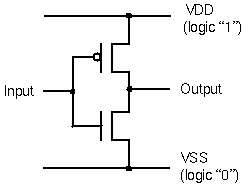
The inverter consists of an NMOS transistor M1 and a PMOS transistor M2. The channel length L of both devices will be set to the minimum 0.6um (2 lambda). The width of the NMOS device weill be set to 3.0um (10 lambda), and the width of the PMOS device will be set to 6.0um (20 lambda). The sizings of of each transistor allow designers to custom the current-drive for each gate based on fan-in, fan-out, and other influential factors. Note that the source and the body (p- substrate) of the NMOS are connected to ground (GND node), while the source and the body (n-well) of the PMOS are connected to the positive supply (Vdd node) even though they are not shown. This is because for most introductory circuit classes, the three port model is used (shown), however, when we are dealing with VLSI design, we must utilize the four-port model which accounts for substrate connections which are vital to preventing the body-effect. We assume that the target fabrication technology is AMI C5N 0.5u CMOS process. The technology name is ami05.
In this example, we use basic Magic drawing commands to layout the inverter. Remember that you can undo just about everything by typing :undo or u.
Start Magic from the Unix prompt:
prompt> magic-Tami05 inverterExpand the graphics window over the screen, but so that you can still see the text window prompt. Remember that the graphics window must be active and the cursor must always point to the graphics window. Zoom out and show the lambda grid so that it is easier to see what you are doing.:zoom 0.5The order in which layers are placed in the graphics window is not important, and so the layout steps described here are by no means unique. Since the device channel width W and length L are specified, we can start by painting the device active areas: p-diffusion for PMOS and n-diffusion for NMOS.
:grid 1The PMOS transistor has the channel width W=6.0um, which is equal to 20 lambda in the selected technology. The channel length L=0.6um equals 2 lambda. The design rules specify that we need at least 4 lambda for the source and drain contacts, plus at least one lambda between the poly gate and the source/drain contacts. Using left and right mouse click, make a box 20 lambda wide and 2+4+4+1+1=12 lambda wide. The command:
:paint pdiffpaints the PMOS active area (p-diffusion). The NMOS transistor has the channel width W=3.0um, which is equal to 10 lambda, and the channel length L=0.6um (2 lambda). Make a 10 lambda (height) by 12 lambda (width) box under the p-diffusion area you already painted. You may want to align the left edge of the box with the left edge of the p-diffusion area. The command::paint ndiffpaints the NMOS active area (n-diffusion). A design rule is that n-diffusion must be at least 10 lambda away from p-diffusion. If you placed the n-diffusion area closer to the p-diffusion area, white dots will appear indicating design rule violation. To move the n-diffusion area, point to the area, type macro s to select the area, and use keypad macros 2, 4, 6, or 8 to move the area until the white dots disappear. At this point, your layout should look something like this:
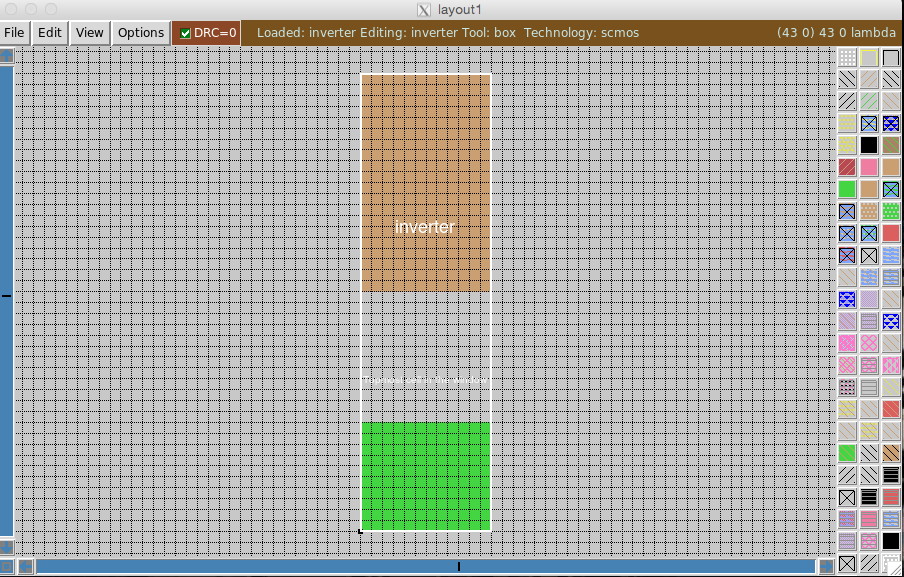
Next, paint horizontal, 6-lambda metal1 wires that will serve as Vdd and GND. Although design rules allow for minimal widths of 4 lambda for m1, making power and ground "rails" wider helps current flow since these wires are used extensively and are connected in many places. Align the top edge of the Vdd wire with the top edge of the p-diffusion. Make this box about 25 lambda wide. The command:
:paint metal1paints the metal1 (Vdd) wire. Then, select the Vdd wire using the s macro, position the cursor to the lower left corner aligned with the left edge of the Vdd wire and the bottom edge of the n-diffusion area, and type c. This will copy the metal1 wire to where the GND wire should be.Next we will add contacts between p-diffusion and metal. Start by making a 4 lambda wide by 20 lambda high that aligns to the left side of the pdiffusion and then type the command:
:paint pdcMake a second 4 lambda wide by 20 lambda high contact aligned with the right side of the pdiffusion.Similarly, make a 4 lambda wide by 10 lambda high box that aligns with the left side of the n-diffusion and type the command:
:paint ndcMake a second 4 lambda wide by 10 lambda high contact aligned with the right side of the n-diffusion. At this point, your layout should look like this:
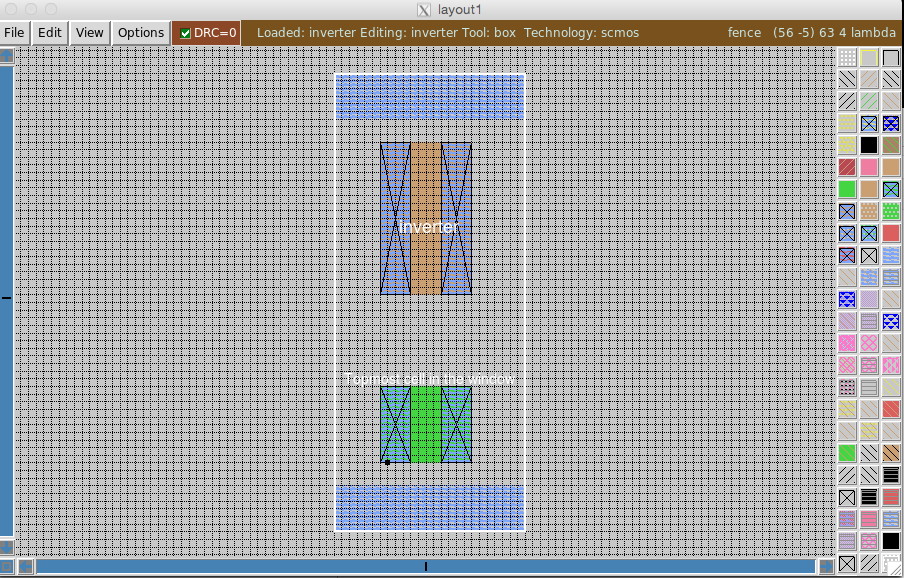
The next step is to paint the n-well area where the PMOS is located. Actually, this step is not necessary, because Magic knows that the n-well is needed for the specified technology, and would automatically generate the required layer for fabrication. Nevertheless, it is a good practice to place the n-well layer by hand. Place a box extending at least 6 lambda below the p-diffusion and 2 lambda above the Vdd bus, and as wide as the metal1 wires. The command:
:paint nwellpaints the n-well for the PMOS. At this point, we can also add contacts between the GND wire and the p-substrate (body of the NMOS), as well as between the Vdd wire and the n-well (body of the PMOS). Place a 4 lambda by 4 lambda box over the Vdd wire. The command::paint nscpaints the n-well to metal1 contact. If the contact is too close to the pdiff to metal1 contact, white dots will appear. Select the n-well-to-metal1 contact you just created and use 4 or 6 keypad macros to move it away until the white dots disappear. Then create a second n-substrate contact near the other end of the Vdd wire.Repeat the same to create two metal1 (GND) to p-substrate contact using the command:
:paint pscThe layout should look like this:
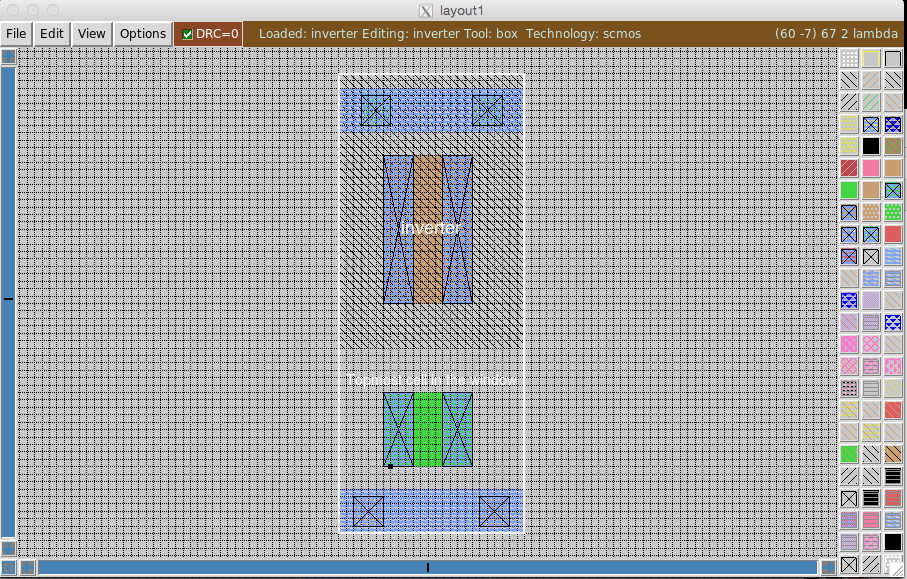
The body contacts (such as the ones you just created) should always be located as close as possible to the device source contacts to minimize the possibility of latch-up that plagues CMOS circuits. It is also a good practice to put as many body contacts as possible.
The next step is to connect the drain contact of the PMOS to the Vdd wire, and the drain NMOS to the Gnd wire by painting small metal1 rectangles between the contacts and the power supply wires. Ian a similar way, connect the two source contacts together with a vertical metal1 wire; this forms the output node. Note that the simplest way to paint a box is to simply click the middle button (i.e. both the left and the right mouse button on a two-button mouse) over the area already painted with the desired layer.
You should now have a layout that looks approximately like this:
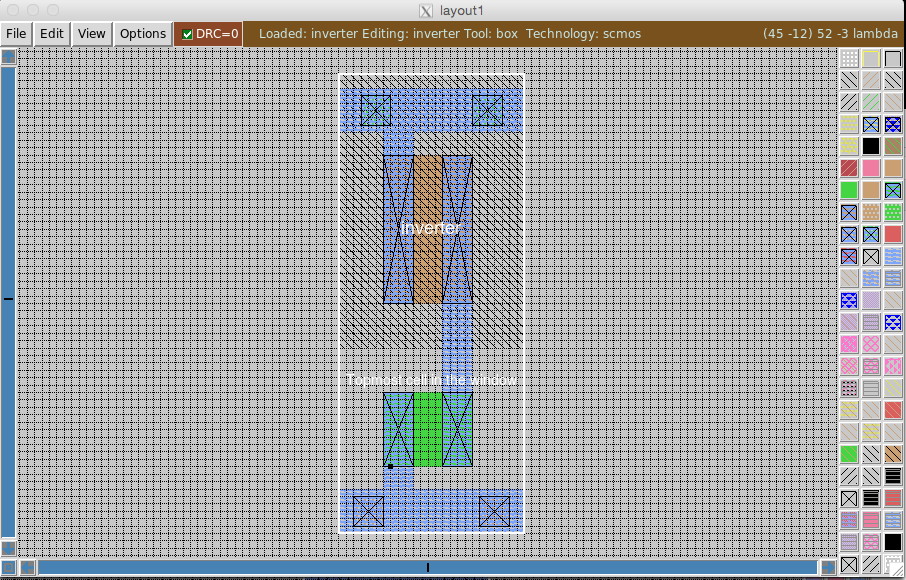
The next step is to paint and connect the gates of the NMOS and the PMOS. Position a 2-lambda wide verticasl box to overlap the middle n-diffusion area by at least 2 lambda on both sides. Type
:paint poly
Notice how the area of poly-to-ndiffusion overlap changes to green/red stripes. This is the channel of the NMOS. Do a similar poly box over the p-diffusion. Correct the size or position of the poly areas if you have white dots indicating design rule violations. Connect the poly areas and make the input node. The layout should look like this:
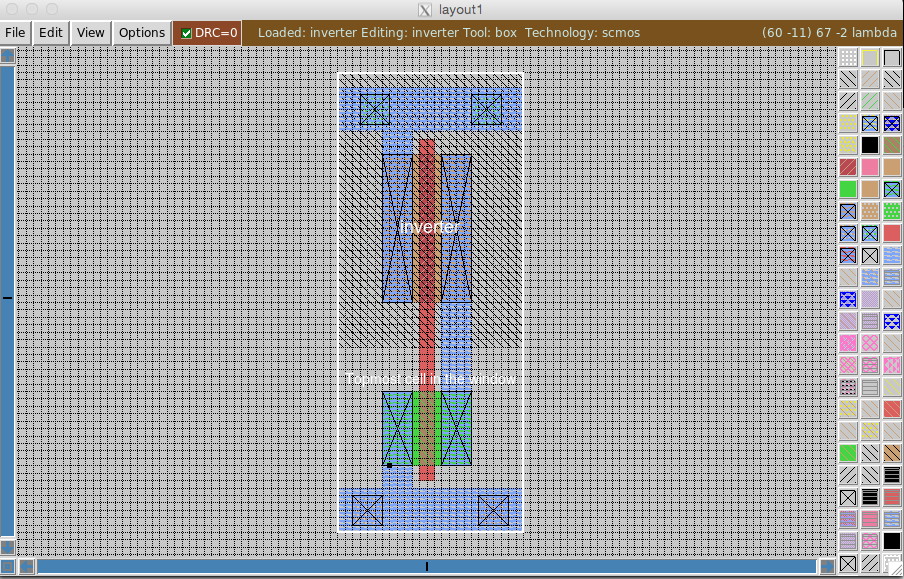
Next, we will connect the polysilicon gate wire to a metal by painting a poly contact on the poly between the two transistors and extending a 4 lambda wide metal1 wire to the left of the cell.
The final steps in the layout are to create is to put labels on the important signal nodes. Left click and than right click on the poly, close to the left edge. You should see a small yellow + at that spot. Then type:
:label A
to label the poly as the input node of the inverter. Similarly, label the Vdd wire as Vdd!, the GND wire as GND!, and the output wire as Y. The final layout should look like this:
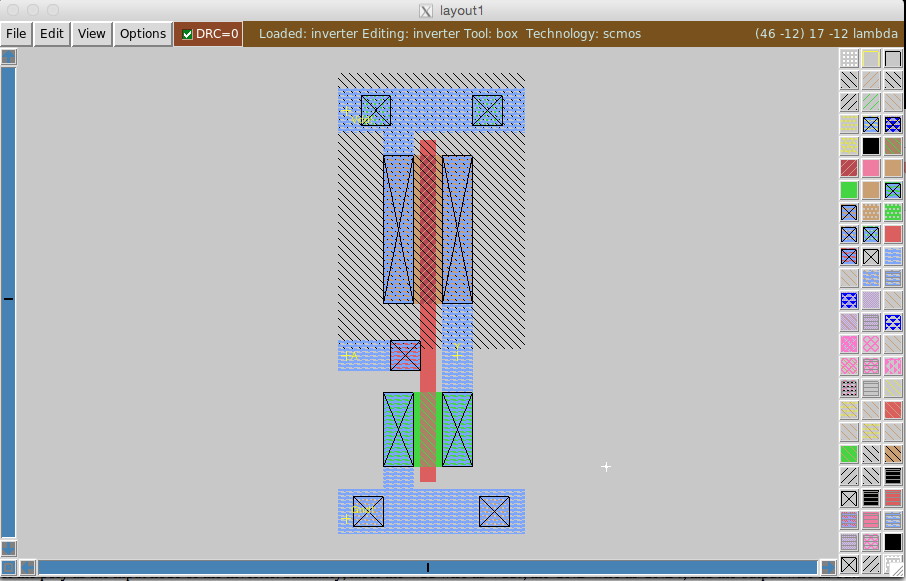
The grid has been turned off using the g macro.
Save the layout you created:.
:saveExtract the layout to create the output file that will be used with a simulator::extractTo exit Magic, type::quit
Cell HierarchiesThe concept of cells is essential for efficient and structured layout of VLSI circuits. The basic idea is quite simple: if you created a layout for a building block (such as an inverter) that can be used in another design or is going to be used many times in the current design, then it is useful to simply include this layout of the building block as a cell. Every time you create and save a circuit in Magic, you have effectively created a cell. Each cell can be included in the hierarchy of a new circuit. The cells you created or the cells created by others in a library can then be put and connected together in a new circuit. Here are basic commands related to working with cells.
Start a new circuit. Then,
:getcell name -- includes a cell that you want in the new circuit.The included cells are shown as "black boxes" with only the instance names showing. No details of the included cell are shown. This is known as the unexpanded form.You can select and manipulate each cell as you could a box of paint. In order to "connect" cells together, you need to know where the "connection points" of a cell are. Thus, expand the cell and paint wires between appropriate points of the cells. The following macros are used to expand or unexpand cells:
x expands a selected cell, all details are visible.If you included a number of pre-designed identical cells and you realize that you need to make one small change to all of them, you can edit just one cell by itself and the changes will be reflected in all the other cells. To edit the cell, type:
X unexpands a selected cell, all details are hidden.:load cell-nameMagic will load that cell (and all of its sub-cells) into the window. Once all changes have been made, :save your changes and :load the circuit you were working on. All changes will be reflected in your circuit's cells.A more detailed explanation of the cell hierarchies can be found in the Magic Tutorial #4: Cell Heirarchies.
Magic Tutorials, Summary of Commands, and Complete Manual PagesMagic comes with a set of tutorials that go through commands, macros, and mouse functions. You may want to go first through the tutorials labeled with *. However, be warned that these tutorials were written for an earlier version of Magic, and in many cases macro commands have changed - use the :macros command when in doubt. Also, please do not print the tutorials or the manual pages on the lab printers - these are large files that can best utilized on-line.
* Magic Tutorial #1: Getting Started
* Magic Tutorial #2: Basic Painting and Selection
* Magic Tutorial #3: Advanced Painting (Wiring and Plowing)
* Magic Tutorial #4: Cell Heirarchies
Magic Tutorial #5: Multiple Windows
* Magic Tutorial #6: Design-Rule Checking
Magic Tutorial #7: Netlists and Routing
* Magic Tutorial #8: Circuit Extraction
Magic Tutorial #9: Format Conversion to CIF and Calma
Magic Tutorial #10: The Interactive Router
Magic Tutorial #11: Using RSIM with MagicMagic User's Guide from opencircuitdesign.com
Magic manual page
Prepared by James Stine, Oklahoma State University and revised by John Nestor, Lafayette College. Last updated: January 25, 2017.
